Card Sorting Example
Hope you’ve already studied all the basics of card sorting UX research technique, it’s specifics and advantages and are ready to look at the card sorting example. If no, make sure to go through these pages:
Learn about the process in this Card Sorting Guide, compare the Pricing, get familiar with Information Architecture and Optimalsort and discover card sorting Tips & Tricks.
Now, let’s jump right into it.
What is card sorting exercise?
Card Sorting exercise is a simple user research activity used for evaluating the information architecture of your digital products. It implies giving respondents a set of cards and asking them to sort them in an intuitive way.
Card sorting exercise is used by many researchers to build intuitive navigation systems, categorize content and label it in a user-friendly way.
Card Sorting example: financial company website
To give you a real example of how card sorting activity can improve website’s navigation and UX overall I did some research and found this amazing card sorting case study. The study was published on Medium by John Nicholson, you can check it out here.
Let’s break this card sorting example down and take a closer look at the goals of the study, as well as its outcomes.
The goal
This card sorting activity was a part of a big research project done by John Nicholson and a marketing team of a Fortune 500 company. In his case study he mentions that the company was a worldwide famous enterprise in the financial sector. Their marketing team had a goal to create a microsite with a bunch of brand content. The site needed its own navigation and the team was struggling to structure more than 100 pieces of content in a user-friendly way.
That’s where John Nicholson and card sorting came in.
Even though they were skeptical at first, John persuaded the team to take a full month dedicated to user research and UX design, which would include a card sorting exercise and a tree test to evaluate its results.
Card sorting exercise
John and his team designed a card sorting exercise with a total of 100 cards. All of them represented the pieces of content that needed to be sorted for the future website. They started the research with 5 remote think-aloud open card sorts. This allowed John to get qualitative insight and understand the user’s actions better during the exercise. Leter, to get more quantitative data, they also conducted 50 more card sorts, this time – unmoderated.
The results
Using an online card sorting tool John and his team were able to gather enough data for 3 potential IA models for their future content website. As John shares in his study, these 3 models were later evaluated in a tree test and the winner outperformed other models by 75%!
The insight
Card sorting exercise is a budget-friendly and easy activity to perform when you need to improve your website’s navigation. It’s a great way to increase the findability of your content and make sure that users don’t get lost while trying to navigate through.
Preparing for s card sorting exercise requires some knowledge of key points you need to pay attention to. Below we explain how to run a card sorting exercise and do your best to prepare it.
How to prepare for your card sorting study?
First and foremost, you’ll need to decide if your card sort is going to take place online or offline. Both options are pretty great, but for bigger insights I would recommend going with the first option.
Some of the advantages of online card sorting are:
- Affordable price
- An opportunity to target and filter your respondents
- Much faster
- Detailed reports and easy-to-analyze visuals
In case you chose to conduct your study online, it’s time for the next step.You need to choose the perfect online card sorting tool for your study. To help you, we created this ultimate list of best online Card Sorting tools. Feel free to check it out!
Next, choose the type of card sorting that suits you best. It always depends on the goals of your study.
Open Card Sort – testers sort cards into groups which they label themselves. Great choice when you want to understand how users group your content.
Closed Card Sort – it’s when you give respondents categories to sort the cards into. I recommend this one, in case you want to find out how users match cards with existing content structure.
Hybrid Card Sort – respondents sort your cards into defined categories or create their own. Combining the best of Open and Closed Card Sorting, it allows you to validate information grouping strategy while still leaving respondents room for free expression.
More on what type to choose in this Card Sorting Guide.
How to run a Card Sorting exercise?
There are 5 main steps you need to take in order to setup and run a card sorting exercise:
- Create cards and categories
- Write your questionnaire
- Recruit the respondents
- Inform and engage
- Analyze the results
In this example we will be working on improving a parenting magazine’s website navigation. There are content topics that need to be organized into categories on the website’s menu. These content topics are going to be represented by our cards.
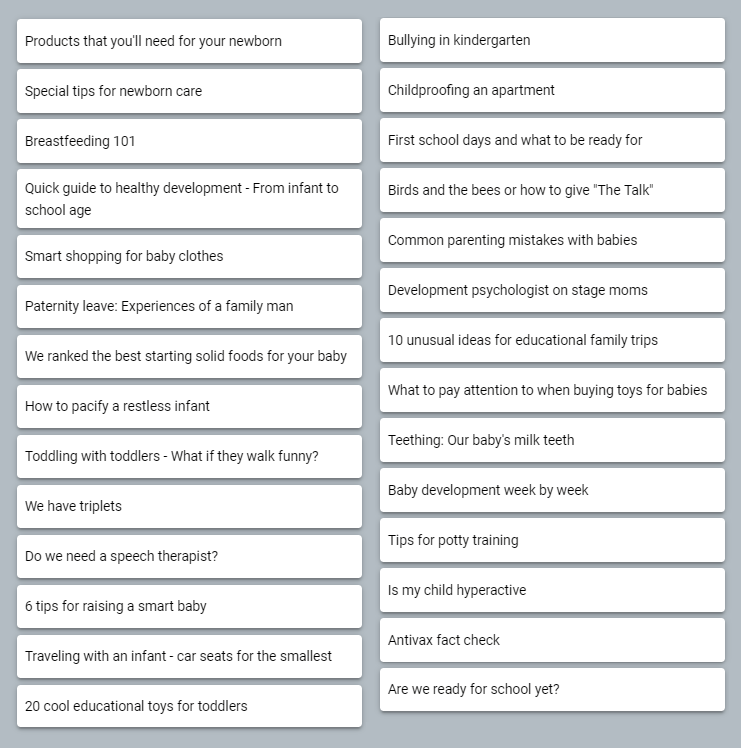
Creating cards and categories
So, the first step is to brainstorm your cards. Depending on your niche and the goal of your study you might wanna be sorting content titles, specific products, items from the menu etc.
Remember, your cards should be easy to read and comprehend. Try not to use too professional language if you’re not sure the users will understand it.
When possible, try to illustrate your cards with images, to make the sort easier for the respondents. Check out our card sorting Tips & Tricks page for more info on the topic!
For Closed and Hybrid card sorting you’ll also need to prepare category labels.
Keep in mind, you want all or most of your cards to be sorted. That’s why it’s important that you have enough categories covering all the possible groups. The more, the better.
Here are some categories we chose for this card sorting example:
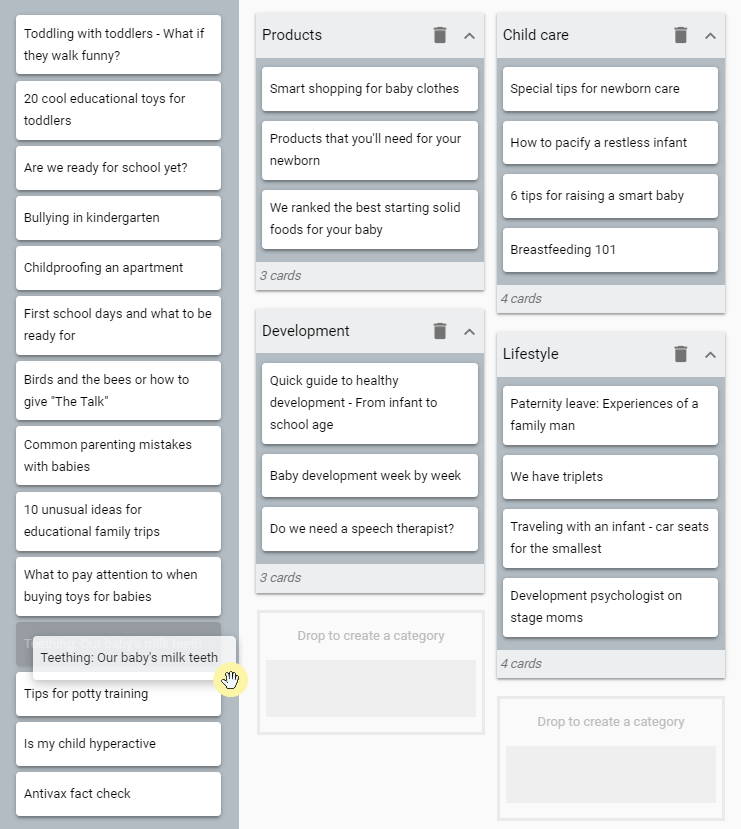
Write your questionnaire
Questionnaires before and after your study are important for gathering all types of info about the users. This will allow you to screen your respondents and filter out the irrelevant ones. Moreover, you can learn more about their preferences and experiences, opinions on your product or the study.
- Pre-study question
A great place for your screener. There you can also ask for some additional information about the respondent, their demographics or experience with your product.
- Post-study question
Can be used for gathering any type of additional feedback. Ask some relevant questions and let respondents express themselves. In this card sorting study example we decided to go with 3 questions, all of them pre-study.
- Are you a parent of at least one child that is 0 to 12 years old? (screener)
- What is your gender? (dropdown select)
- What do you read Super Mom Magazine for? (multiple choice)
Recruit the respondents
There are multiple handy ways to do that, so you don’t have to worry about not getting enough participants.
Some of the options are:
- Recruiting from a respondent pool (many online card sorting tools provide that option for a quite reasonable price)
- Sharing a link via email
- Asking people to join your study on social media
- Recruiting directly from the website (with the help of the Recruitment widget)
In this example of card sorting we shared a link to our study via email newsletter and used the Recruitment widget on the website, offering a discount code for every finished sort. That is a great practice for motivating people to attend your research.
An ideal number of participants for your study is 30-50.
Inform and engage
Prepare a short instruction and a Welcome Message to show before the study, explaining the process and the goals of the sort. Don’t forget to tell your testers how appreciated their help is!
Most of the online card sorting tools have these instructions by default, but you can usually customize them as well.
Here’s an example of the one we used in this card sorting study:
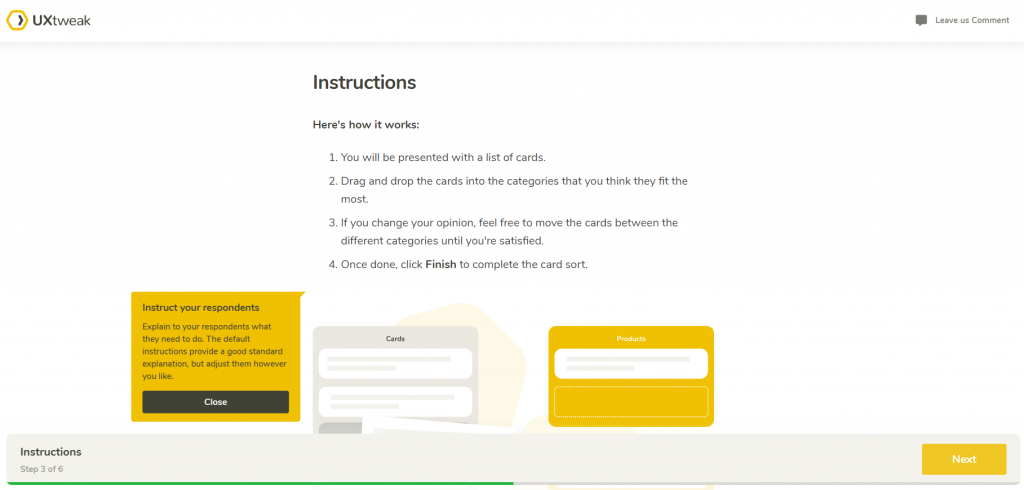
Card sorting example study results
After you launch your study and get some completed sorts you’ll be able to start analyzing the data. Some of the softwares will provide you with advanced analytics, some will be more basic. You can learn more about each of them in this list of best online Card Sorting tools.
There are two suggested ways to look at the results of your research.
Exploratory analysis is an approach where you go through the results searching for ideas using your intuition and creativity.
Statistical analysis is focused on numbers. Card sorting tools offer many views on data. You can use the standardization grid, similarity matrix, dendrograms, results matrix, popular placements matrix, and many others.
All of the results are visually represented and easy to read and comprehend. Here’s what we got in our card sorting example study:
A study overview with the respondents’ information:
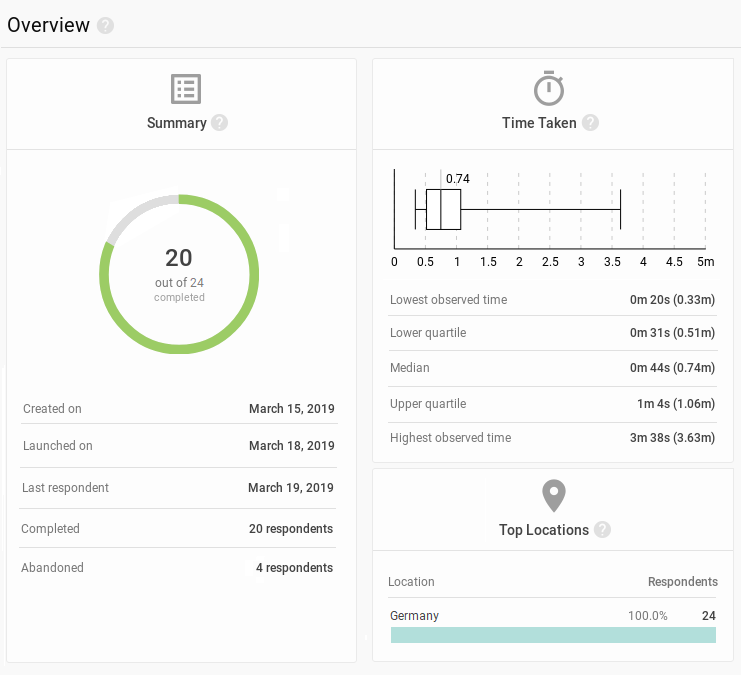
Standardization grid:
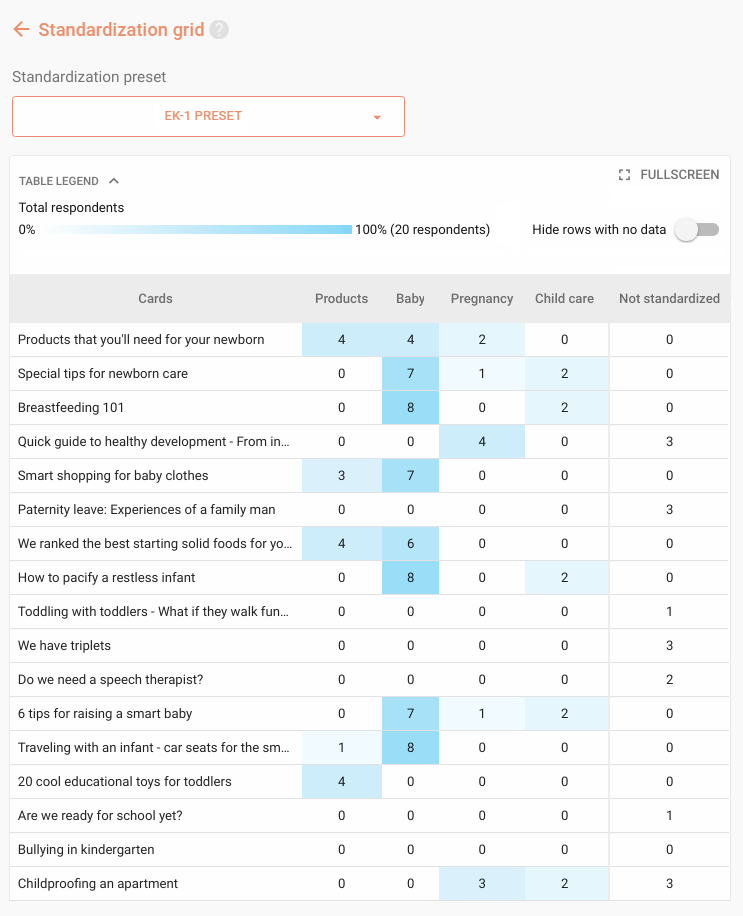
Similarity Matrix:
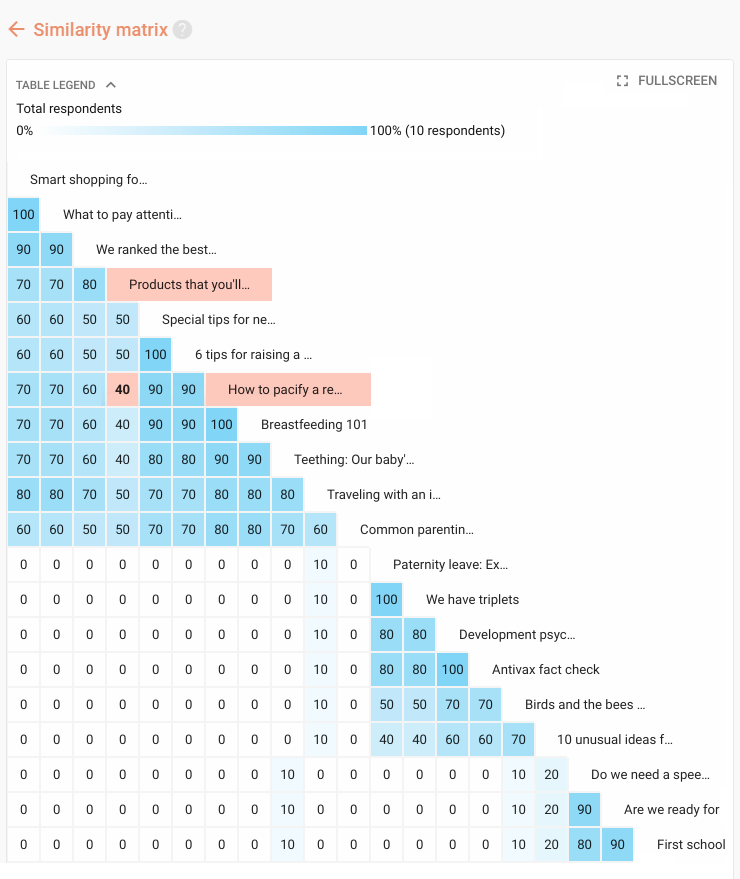
And other countless graphs and charts that’ll help you organize your website in a user-friendly way!
Try card sorting example study for yourself using these handy demos:
open card sorting, closed card sorting, and hybrid card sorting.
Check the example of a PDF report as well.
Card Sorting Example & Exercise
Hope you’ve already studied all the basics of a card sorting exercise, it’s specifics and advantages and are ready to look at the card sorting example. If no, make sure to go through these pages:
Learn about the process in this Card Sorting Guide, compare the Pricing, get familiar with Information Architecture and Optimalsort and discover card sorting Tips & Tricks.
On this page we are going to go through a card sorting exercise example and explain how to run a card sorting exercise yourself. Now, let’s jump right into it.
What is card sorting exercise?
Card Sorting exercise is a simple user research activity used for evaluating the information architecture of your digital products. It implies giving respondents a set of cards and asking them to sort them in an intuitive way.
Card sorting exercise is used by many researchers to build intuitive navigation systems, categorize content and label it in a user-friendly way.
Card Sorting example: financial company website
To give you a real example of how card sorting activity can improve website’s navigation and UX overall I did some research and found this amazing card sorting case study. The study was published on Medium by John Nicholson, you can check it out here.
Let’s break this card sorting example down and take a closer look at the goals of the study, as well as its outcomes.
The goal
This card sorting activity was a part of a big research project done by John Nicholson and a marketing team of a Fortune 500 company. In his case study he mentions that the company was a worldwide famous enterprise in the financial sector. Their marketing team had a goal to create a microsite with a bunch of brand content. The site needed its own navigation and the team was struggling to structure more than 100 pieces of content in a user-friendly way.
That’s where John Nicholson and card sorting came in.
Even though they were skeptical at first, John persuaded the team to take a full month dedicated to user research and UX design, which would include a card sorting exercise and a tree test to evaluate its results.
Card sorting exercise
John and his team designed a card sorting exercise with a total of 100 cards. All of them represented the pieces of content that needed to be sorted for the future website.
They started the research with 5 remote think-aloud open card sorts. This allowed John to get qualitative insight and understand the user’s actions better during the exercise. Later, to get more quantitative data, they also conducted 50 more card sorts, this time – unmoderated.
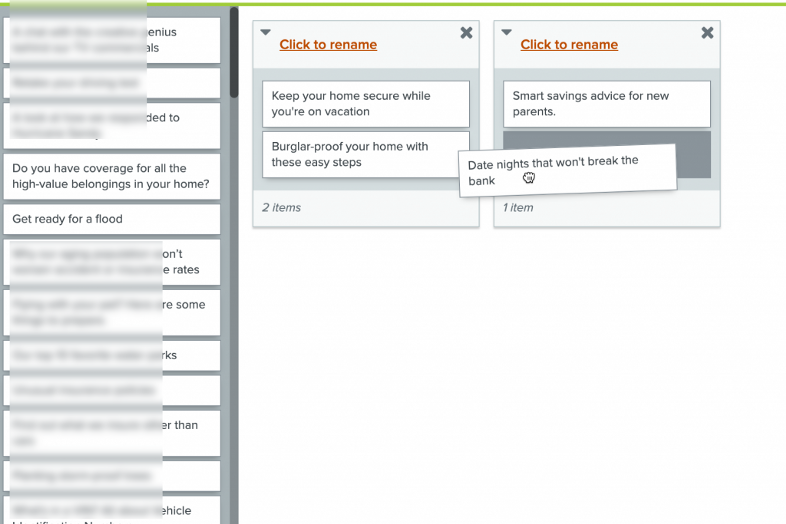
John shares a screenshot from the study on Medium.
The results
Using an online card sorting tool John and his team were able to gather enough data for 3 potential IA models for their future content website. As John shares in his study, these 3 models were later evaluated in a tree test and the winner outperformed other models by 75%!
The insight
Card sorting exercise is a budget-friendly and easy activity to perform when you need to improve your website’s navigation. It’s a great way to increase the findability of your content and make sure that users don’t get lost while trying to navigate through.
Preparing for s card sorting exercise requires some knowledge of key points you need to pay attention to. Below we explain how to run a card sorting exercise and do your best to prepare it.
How to prepare for your card sorting study?
First and foremost, you’ll need to decide if your card sort is going to take place online or offline. Both options are pretty great, but for bigger insights I would recommend going with the first option.
Some of the advantages of online card sorting are:
- Affordable price
- An opportunity to target and filter your respondents
- Much faster
- Detailed reports and easy-to-analyze visuals
In case you chose to conduct your study online, it’s time for the next step.You need to choose the perfect online card sorting tool for your study. To help you, we created this ultimate list of best online Card Sorting tools. Feel free to check it out!
Next, choose the type of card sorting that suits you best. It always depends on the goals of your study.
Open Card Sort – testers sort cards into groups which they label themselves. Great choice when you want to understand how users group your content.
Closed Card Sort – it’s when you give respondents categories to sort the cards into. I recommend this one, in case you want to find out how users match cards with existing content structure.
Hybrid Card Sort – respondents sort your cards into defined categories or create their own. Combining the best of Open and Closed Card Sorting, it allows you to validate information grouping strategy while still leaving respondents room for free expression.
More on what type to choose in this Card Sorting Guide.
How to run a Card Sorting exercise?
There are 5 main steps you need to take in order to setup and run a card sorting exercise:
- Create cards and categories
- Write your questionnaire
- Recruit the respondents
- Inform and engage
- Analyze the results
In this example we will be working on improving a parenting magazine’s website navigation. There are content topics that need to be organized into categories on the website’s menu. These content topics are going to be represented by our cards.

Create cards and categories
So, the first step is to brainstorm your cards. Depending on your niche and the goal of your study you might wanna be sorting content titles, specific products, items from the menu etc.
Remember, your cards should be easy to read and comprehend. Try not to use too professional language if you’re not sure the users will understand it.
When possible, try to illustrate your cards with images, to make the sort easier for the respondents. Check out our card sorting Tips & Tricks page for more info on the topic!
For Closed and Hybrid card sorting you’ll also need to prepare category labels.
Keep in mind, you want all or most of your cards to be sorted. That’s why it’s important that you have enough categories covering all the possible groups. The more, the better.
Here are some categories we chose for this card sorting example:

Write your questionnaire
Questionnaires before and after your study are important for gathering all types of info about the users. This will allow you to screen your respondents and filter out the irrelevant ones. Moreover, you can learn more about their preferences and experiences, opinions on your product or the study.
- Pre-study question
A great place for your screener. There you can also ask for some additional information about the respondent, their demographics or experience with your product.
- Post-study question
Can be used for gathering any type of additional feedback. Ask some relevant questions and let respondents express themselves. In this card sorting study example we decided to go with 3 questions, all of them pre-study.
- Are you a parent of at least one child that is 0 to 12 years old? (screener)
- What is your gender? (dropdown select)
- What do you read Super Mom Magazine for? (multiple choice)
Recruit the respondents
There are multiple handy ways to do that, so you don’t have to worry about not getting enough participants.
Some of the options are:
- Recruiting from a respondent pool (many online card sorting tools provide that option for a quite reasonable price)
- Sharing a link via email
- Asking people to join your study on social media
- Recruiting directly from the website (with the help of the Recruitment widget)
In this example of card sorting we shared a link to our study via email newsletter and used the Recruitment widget on the website, offering a discount code for every finished sort. That is a great practice for motivating people to attend your research.
An ideal number of participants for your study is 30-50.
Inform and engage
Prepare a short instruction and a Welcome Message to show before the study, explaining the process and the goals of the sort. Don’t forget to tell your testers how appreciated their help is!
Most of the online card sorting tools have these instructions by default, but you can usually customize them as well.
Here’s an example of the one we used in this card sorting exercise:

Analyze the results
After you launch your study and get some completed sorts you’ll be able to start analyzing the data. Some of the softwares will provide you with advanced analytics, some will be more basic. You can learn more about each of them in this list of best online Card Sorting tools.
There are two suggested ways to look at the results of your research.
Exploratory analysis is an approach where you go through the results searching for ideas using your intuition and creativity.
Statistical analysis is focused on numbers. Card sorting tools offer many views on data. You can use the standardization grid, similarity matrix, dendrograms, results matrix, popular placements matrix, and many others.
All of the results are visually represented and easy to read and comprehend. Here’s what we got in our card sorting exercise:
A study overview with the respondents’ information:

Standardization grid:

Similarity Matrix:
And other countless graphs and charts that’ll help you organize your website in a user-friendly way!
Try card sorting example study yourself using these handy demos:
open card sorting, closed card sorting, and hybrid card sorting.
Check the example of a PDF report as well.
Here’s a great example of a Card Sort for an e-commerce website:

